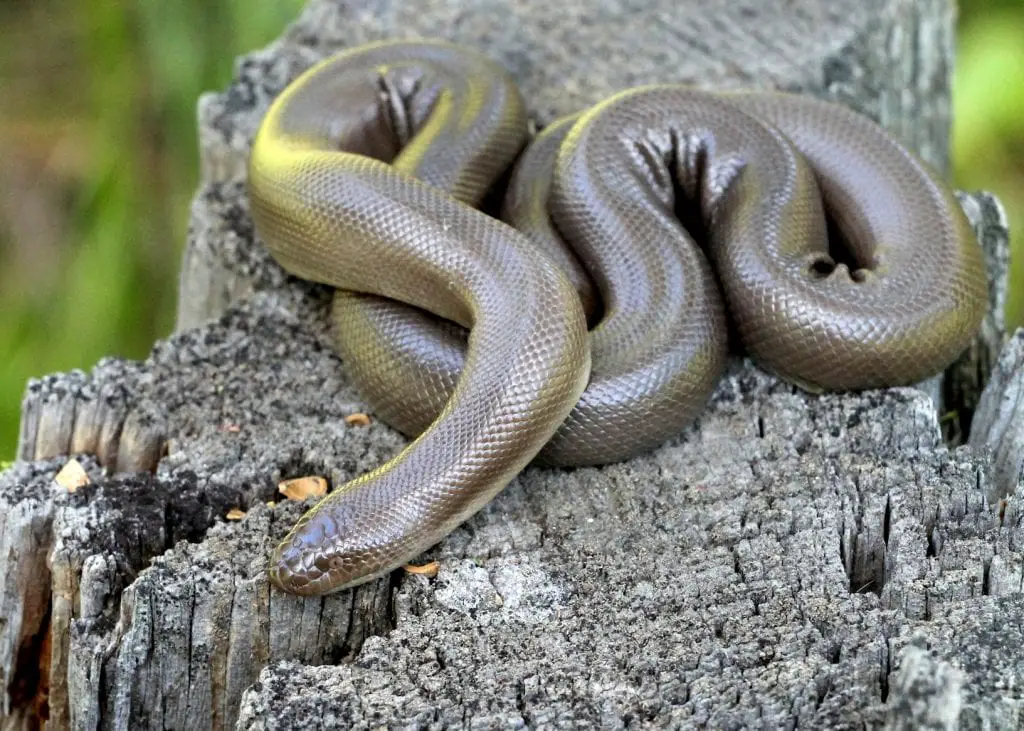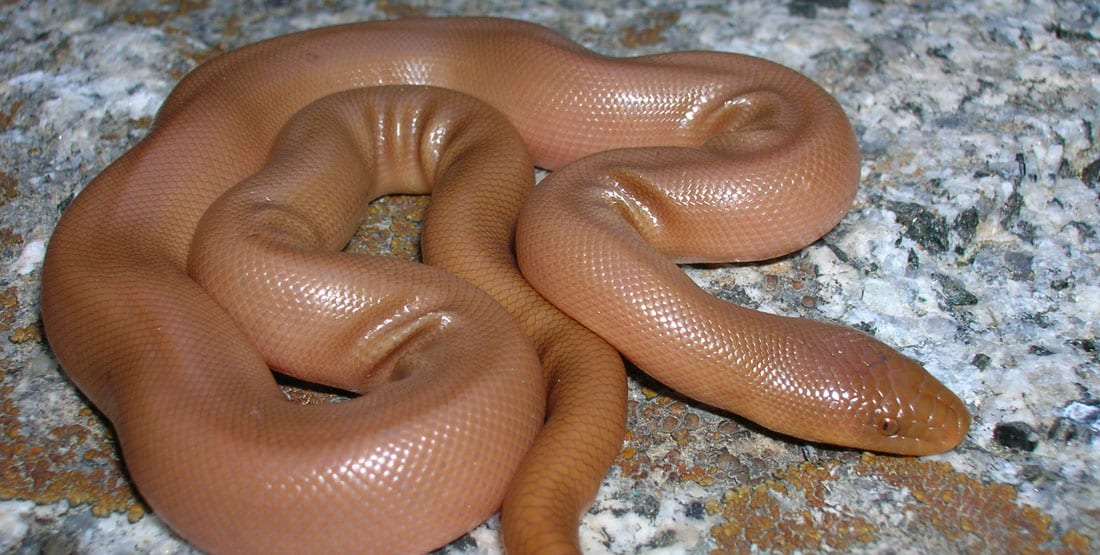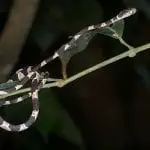Scientific Facts
| Common Name | Rubber Boa |
| Scientific Name | Charina bottae |
| Origin | the western United States that stretches their population throughout the Pacific Coast east to Montana and Utah and as far as the San Jacinto Mountains east of Los Angeles in California, San Bernardino, and as far as southern British Columbia. |
| Habitat | burrows, leaf litter, rocks or logs |
| Diet | young birds, snake eggs, lizard eggs, small lizards, young bats, voles, shrews, and mice |
| Size and Weight | Male: 18 to 21 inches; 70-80 gramsFemale: 23 to 26 inches; up to 200 gramsJuvenile: 7.5 to 9.1 inches |
| Life Span | 20-30 years |
Physical Appearance

The rubber boa is considered the smallest among the boa constrictor species. Their name was derived from the small scales that are seen on their skin, which has a smooth and shiny texture that gives the snake a rubber-like appearance. Their color ranges from tan to dark brown with a ventral surface that has yellow, orange, or olive-green colorations. The juveniles appear to have pinkish skin, but it darkens as it grows into maturity. They have small eyes with elliptical pupils that are positioned vertically. One of their distinct characteristics is the short tails that can be compared to their small heads.
Distribution
The rubber boas are seen mostly on the western United States that stretch their population throughout the Pacific Coast east to Montana and Utah and as far as the San Jacinto Mountains east of Los Angeles in California, San Bernardino, and as far as southern British Columbia. These are the places where there is a high altitude; that is why they can be a pole for boas.
Subspecies
Pacific Rubber Boa
This rubber boa species is a non-venomous snake that is usually seen in Melanesia and Polynesia that has an extended range from Vanuatu, and Fiji, Solomon Islands, Samoa, and American Samoa. Due to their colorations that ranges from red to almost black, they can effectively camouflage
Emerald Tree Boa
The Amazon Basin emerald tree is a boa species found in the rainforest of South America and within the jungles of the Amazon river. It has a coral-like color from its head until the snout. They spend most of their time is to wrap their bodies around the tree canopies. Their green skin coloration is not just to show off, but it is their first line of defense if there is a predator by camouflaging among the leaves.
Southern California Rubber Boa
They are usually seen in the San Bernardino mountains that are characterized by their small bodies and smooth shiny-loose scales. When they are threatened, they would usually hide their heads in their coiled body, and they fool their predator by elevating their tails like they are about to attack. They thrive in mixed-conifer forests where there are logs or debris that serves as their shelters.
Habitat
Rubber boas can be found at around 10,000 feet (3,000 m) around sea level. They are the types of snakes that cannot withstand too hot and dry. They prefer staying in cold regions where it is surprising that they can thrive. They spend most of their time in their burrows, leaf litter, rocks, or logs where there is adequate moisture, warmth, and prey. They also tend to have a small territory compared to other snake species. They usually migrate from one habitat to another due to different factors such as lack of prey and competition. They are light-sensitive, so it is almost impossible to get an encounter with them during the day; they frequently move out hiking trails in the afternoon or at dusk. The months of April, May, and June are the months that they are actively seen in the wild.
Behavior
Rubber boas are considered as a docile boa species; with these characteristics, they are often used to overcome their fear of snakes. They are not known to bite when handled though they release a potent musk from their vent that is quite sticky when they are unease or threatened. They can adapt to different kinds of environmental conditions because they can burrow, climb, and swim. Rubber boa is considered as semi-arboreal snakes that climb in the trees or shrubs in search of food, but as the old and as their bodies become heavier, they would become purely terrestrial.
Because of their skin’s appearance, they tend to dehydrate more rapidly compared to other snakes that are why bodies of water are important to them to maintain their fragile skin. When they are on their defensive state, they tend to have a skin colorations of brown on top and creamy shade on the bottom. They are a cold-tolerant that would even move over through the snow and would even attempt to burrow. They have a maintaining body temperature of about 54 degrees Fahrenheit. Aside from biting when they are threatened, they would also use their tails to distract their predators.
Diet
The rubber boas usually feed on mammals and reptiles such as young birds, snake eggs, lizard eggs, small lizards, young bats, voles, shrews, and mice. There are also instances of them eating small snake species.
Breeding and Reproduction
The mating season occurs early in the spring just after the reemergence from hibernation. Unlike almost all snake species that give birth to eggs, rubber boas are ovoviviparous species wherein they give birth to live young. Most females only reproduce after 4 years with a number of about 9 offspring. The juvenile rubber boas rend to have 7-9 inches long, and it would take about 2 to 3 years for it to sexually mature. They look the same as the adults but just differ in color because they are born to have a pink appearance, but it will become darker as they mature.
Size and Weight
They are not considered as a large snake; instead, they have a stout, small, and shiny body. The males have an average size of about 18 to 21 inches in length with a weight of 70-80 grams while the females tend to be larger with a usual length of 23 to 26 inches that has a weight that would exceed 200 grams, especially if they are pregnant. The newborn rubber boa has a length of 7.5 to 9.1 inches (19 to 23 cm).
Lifespan
The rubber boa has a lifespan of about 20-30 years in the wild and even more than 30 years in captivity.
Shedding
Shedding is common to all reptiles. It is a good indication that the snake is growing continuously. When your rubber boa sheds its skin, there are signs or changes that will happen to them prior to the actual shedding, such as having blue eyes, dull appearance, loose-looking skin in the head an head and jaw area and refusal to eat. These signs happen 2-3 days after the actual shedding. The rubber boa will shed its skin every month or two, especially during their juvenile years. You should be able to distinguish a good and a bad shed. If the snake will shed in patches, then there is something wrong in its environment.
Common Disease/Illnesses
Pneumonia and respiratory issues
The humidity and temperature level are the causes of pneumonia and respiratory illnesses. Rubber boa thrives in a humid and average temperature when you expose this snake in a hot or too cold temperature; that is the time that the snake’s immunity is affected, making them prone to different kinds of illnesses, specifically respiratory illnesses.
Your snake will have a nasal discharge when they have a respiratory illness that will be a barrier for them to breathe in easily. Mouth gaping, excessive salivations, mouth discolorations, and excessive mucus discharge are just some of the possible signs that your snake is suffering from a respiratory illness
When not attended to as soon as possible, it may lead to death. As soon as you see that the snake has nasal discharge, take it to your veterinarian so that they could give first aid or antibiotics. Experts suggest that before taking it into captivity, you already have knowledge about these kinds of diseases.
Parasites Infestations
Like any other animal, this snake is easy gets infected with parasites infestations, especially if they are staying in an unsanitized environment. Another way by which your snake gets infested with different kinds of parasites is when you frequently handle them with dirty hands. If these parasites are not avoided, it may lead to some skin diseases that may be dangerous to their health.
To avoid this kind of inconvenience, make sure to always clean and sanitized the tank of your snake as well as the accessories in it. Also, avoid taking them out from their tank, especially in dirty places that will make their skin dirty. When you notice that there are already parasites in your snake’s tank, it is an indication that you need to attend to the cleanliness of the environment.
Blister Disease
An unsanitary environment for your snake may lead to different kinds of skin diseases, one of which is the blistering disease. When your snake is infested with this disease, it will not only cause pain, but it will be a cause of irritation that may be a triggering factor for their aggressiveness. It may be a mild disease, but when not taken care of; it may cause septicemia, which is fatal.
Your snake both prefer wet and dry conditions, but there should be a balance. They should only be exposed to wet conditions when they need to moisturize themselves to stay hydrated, but too much exposure causes this disease. You need to apply ointments to the affected area so as not to aggravate the skin’s condition. It is also advisable to always maintain a dry environment for them; that is why you need to observe their drinking and soaking activity to check the water spillage.
Anorexia
This is quite difficult to observe if you do not have an idea about anorexia to snakes. When you see them vomiting and re-swallowing their food, you’ll perceive that this is just a normal thing for snakes. Another manifestation that your snake is anorexic if it doesn’t have an appetite for food. Loss of appetite for snakes is just a normal thing if the weather is too hot or too cold or its shedding season.
You would know that your snake is most probably facing anorexia issues if your snake also looks weak. A remedy so that your snake will not have a hard time swallowing those that are feathery food is to remove the feathers and serve it clean. The veterinarian has the ability to detect whether or not your snake is suffering from it, that is why when you see these signs, better consult your veterinarian for a possible cure.
Egg binding
This is quite a severe disease; a snake suffers because of the inability to give birth smoothly. The eggs tend to be trapped in the organ of the snake, especially if the eggs are large. If it can be detected earlier that there are still eggs that are trapped, surgery may be needed to avoid complications. Since it is not really observable if there are still eggs inside, it is important to always ask your veterinarian to check the snake’s condition after giving birth.
This is a severe condition because it is fatal. When the eggs aren’t released, it will be spoiled inside, leading to some complications. Days after the actual giving birth process, the snake may be aggressive because of the irritability it experiences. This disease can’t be avoided, but you can be attentive to avoid aggravating the situation and to help save the snake’s life span.
Regurgitation
This happens when the snake has the inability to swallow or digest the pre it eats. This is common for snakes that were imported or wild-caught reptiles. If your snake has regurgitation, it leads to the loss of electrolytes and some important fluid that makes them weak. The possible causes are poor husbandry, over-sized prey, stress, and nervousness due to mishandling and dehydration.
Preventing Illness
You can’t dictate the health of your pet, but you can always be keenly observant and attentive to their needs. Sometimes, these are just some of the qualities that you need for you to save the life of your snake because the common diseases or illnesses of snakes can be treated when attended to immediately.
It is important to know how to determine the severity of the snake’s skin condition to know what to consult your veterinarian as soon as possible, but experts would say that for you to be able to extend the lifespan of your snake, treat all cases urgent so as not to prolong the agony of the snake.
Captive Breeding
Rubber boa captivation is becoming popular nowadays. In the list of snakes taken as a pet, rubber boa is on the top though they are not easily seen in some pet shops or pet trades that is why you have to do research. As long as proper handling and care are given to them, for sure these reptiles can be a good pet.
It is always advisable to start with young rubber boa if you would take it into captivity so that it would be easy for you to tame it. Your goal as a breeder is to ensure that your pet recognizes you as their owner by giving its basic needs. In choosing for the right kind of rubber boa to a pet in captivity, you may ask help from a local pet shop where you could also acquire it to be sure that it is healthy and free from pest infestations
Availability- Where to Get One?
Rubber boas are hardly seen in captivity because of their availability. The states where it originates do not allow the residents to hunt for these snakes to breed into captivity. Another part is the lack of interest from the pet collector. If you want to have this in captivity, you must be able to search for the internet because sometimes there are pet trades that display rubber boa for sale.
How to Care Reptile as a Pet
Housing
Rubber boas have a petite body; that is why they do not need to have a large tank. An ideal tank for them is at least five or ten-gallon capacity. They are an excellent escape artist because they can just easily pass through a small hole or crack that is why their tank should be in good condition with a secure lid. These are hardy reptiles as long as there are no husbandry issues.
Light and Temperature
They are cold tolerant; that’s why you also need to ensure that their tank is at the ideal temperature always, which is at 83 to 85 degrees Fahrenheit. There should be two areas in their tank, one area for basking should have a maintaining temperature at 85 degrees, and one area should have a temperature that does not have a temperature below 65 degrees Fahrenheit. When the room temperature is at 70 to 75 during summer, this is a good temperature aid for digestion thus, basking under lighting set-up is no longer required.
Feeding
Their diet in captivity is usually from mice, whatever age they are in. Even though they have a small physique, they have the ability to stretch their mouths to eat their prey. Newborn rubber boas tend to overwinter because they’ll refuse to eat until the late spring or summer season. There are some recordings that they do not eat for about 18 to 20 months, so if your juveniles are like this don’t panic because this is just a normal process for them. Experts suggest that it make it happens because of the cool temperatures that they are in the body see it as a sign for the winter season. Rubber boas eat at least once a week since they are small, they also have a slow metabolism.
Water
Clean fresh waterer should be given always. When your pet defecates, it can’t be avoided that there will be no particles that will be placed in the water. These types of snakes will sense if their water is clean or not, they will not drink if the water in their bowl is stale. So to ensure proper hydration, make sure that you always drink fresh water.
Sound and Vibration
Sounds and vibrations that they feel may become a stressor to your pet. Some vibrations that may cause them stress are closing of the doors, recreational equipment sounds, and knocking on their housing’s glass. It is important to place them in a room or in a place in your house where these factors can be avoided so as not to bring out the aggressive behavior in them. Stress that is caused by sounds and vibrations attracts a negative impact on their health.
Substrate and Accessories
The excellent substrate for their tank is aspen chips, bark shards, cypress or fir together with fine sand. They also need to have trunks or logs where they can climb to bask. You also need to properly place the basin or bowl where you can place their water for soaking or drinking. It is advisable to at least provide these snakes with an environment that is just like their natural habitat. You can place some newspapers on their tank so that you can easily collect their fecal.
Cleanliness
These snakes release watery waste frequently; that is why you need to constantly clean their tank to avoid the smell and build-up of bacteria. Make sure that the water will not overflow because if it overflows, the substrate will be damp, and their skin will soak making it prone to skin diseases and fungal infections. The cleanliness of their tank influences how they will healthily. When their tank is unsanitized, there is a possibility that your snake will be prone to different kinds of diseases and illnesses because their immune system is affected.
Handling
These species are shy and timid snakes making it a bit difficult to handle them. When threatened, their first course of action is to always hide. You may need to get used to handling them for you to get comfortable. There were observations that these snakes have unique personalities from being shy to aggressive.
There are different kinds of illnesses that the snake will get from handling them too frequently because of the stress that they can experience, making them irritated. Handling them once in a while is advisable so that you can observe the snake’s body for a possible pest infestation or skin disease.
Conservation Status
Aside from illegal hunters, they are being preyed upon by large predators such as hawks, raccoons, cats, coyotes, and raptors. They still have a good number in captivity because they are good at camouflaging, and they would usually spend most of their time underground.
FAQ Section
Is a rubber boa venomous?
The rubber boa is a small non-venomous snake. They may bite, but it is not fatal to humans.
Do rubber boas have teeth?
They have teeth, but these are primarily for eating. They only bite if they are extremely threatened.
Are rubber boas aggressive?
Boa constrictors such as rubber boa are not generally considered intentionally aggressive or vicious pets; they only show aggressiveness if they are threathened.
Can a rubber boa kill a human?
They only squeeze their prey to death. If they bite humans, they do not have a venom that is fatal; however, their bite may be painful and bloody.
Is it normal for a snake to eat another snake?
It is normal for them to eat other snakes that are smaller to them. They also like to feed on snakes or hatchlings when they search for burrow with eggs on it; that is why they are called prophages. The personality of this snake is that they won’t threaten other snakes to be their prey.
How do they kill their prey?
They are constricting snakes that kill their snake by means of crushing it until it dies before swallowing it. In captivity, it is always advisable not to give them live animals.
How do I tell a male from a female rubber boa?
Both males and females have visible spurs, but females tend to have a smaller spur than the males. For juveniles, you can use a magnifying glass to determine it.
Do rubber boas snakes make good pets?
These snakes are recommended for those who have a fear of snakes. Its temperament and behavior help those who have a fear to overcome it, making it a good pet.
Can a multiple rubber boa snake stay in one housing?
You can place two snakes in one tank, preferably one male and one female, especially if you are into breeding and reproduction; just be sure that it is large enough for them to move and as long as you can supply their daily needs. Any way these species are not aggressive, and they are not territorial like other snakes.
Is it still allowed to take them into captivity?
These species are not included in the list of threatened species, but taking them into captivity is a bit difficult because of availability. Hunters also have a hard time getting it into wild because they are good in hiding.
How often does rubber boa eat?
A rubber boa should be fed at least once every two weeks. You should closely monitor their diet so that they won’t become overweight and obese.
Is there a need to bathe my rubber boa?
Bathing helps in relieving issues such as constipation and different skin problems in your snake. It also promotes shedding and kills pest infestations. When bathing your snake, make sure to use filtered water or warm spring.



